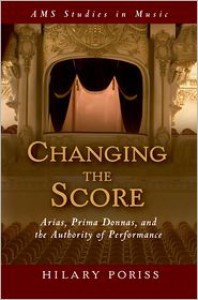 While somewhat dry and repetitive in the early chapters (an inevitability given the need to establish names, dates and other minutiae of historical performance), this is overall a rather engaging and interesting look at the phenomenon of the insertion aria, the divas and divos who drove the practice, and the social and musical/conductorial/technological changes that ultimately led singers to cease adding or substituting extraneous arias to operatic roles. The chapter dedicated to Caroline Ungher is very well done and thoroughly researched and I also greatly enjoyed the later chapter detailing the varied history (pre- and post- Adelina Patti) of the insertion aria in Rosina's lesson scene in 'Il barbiere di Siviglia'. Poriss takes her survey into the 20th century with a brief account of the insertion aria in modern-day performances of 'Il barbiere' and the controversy surrounding Cecilia Bartoli's substitution of two non-standard Mozart arias into the Metropolitan Opera's 1998 production of 'Le nozze di Figaro'. She ends with a fascinating look at a virtually unknown short story, a 19th century object narrative (first published in 'Fraser's Magazine' in 1849) told from the point of view of what is essentially an insertion aria.
While somewhat dry and repetitive in the early chapters (an inevitability given the need to establish names, dates and other minutiae of historical performance), this is overall a rather engaging and interesting look at the phenomenon of the insertion aria, the divas and divos who drove the practice, and the social and musical/conductorial/technological changes that ultimately led singers to cease adding or substituting extraneous arias to operatic roles. The chapter dedicated to Caroline Ungher is very well done and thoroughly researched and I also greatly enjoyed the later chapter detailing the varied history (pre- and post- Adelina Patti) of the insertion aria in Rosina's lesson scene in 'Il barbiere di Siviglia'. Poriss takes her survey into the 20th century with a brief account of the insertion aria in modern-day performances of 'Il barbiere' and the controversy surrounding Cecilia Bartoli's substitution of two non-standard Mozart arias into the Metropolitan Opera's 1998 production of 'Le nozze di Figaro'. She ends with a fascinating look at a virtually unknown short story, a 19th century object narrative (first published in 'Fraser's Magazine' in 1849) told from the point of view of what is essentially an insertion aria.Highly recommended for classical singers, aficionados of bel canto opera, and anyone interested in 19th century musical performance practice.






